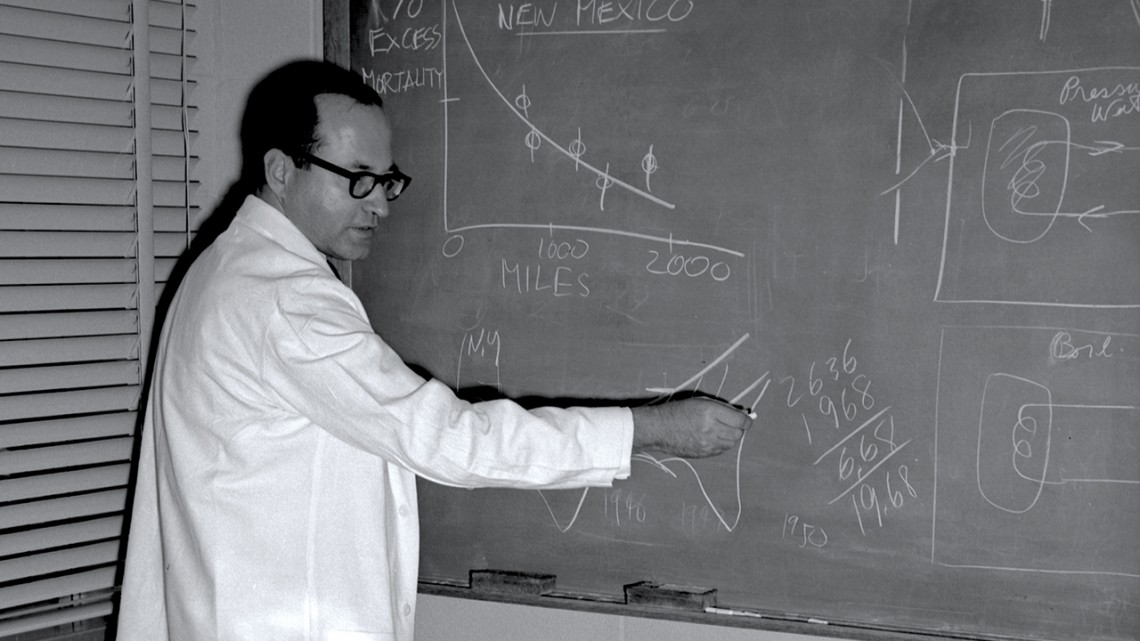
Ernest Sternglass ’44, M.S. ’51, Ph.D. ’53, at the University of Pittsburgh School of Medicine, where he was a professor of radiation physics.
Remembering physicist Sternglass, who helped the world see man on the moon
By Jose Beduya
The ghostly, black-and-white image of Neil Armstrong setting foot on the moon on July 20, 1969, was a spectacle that has replayed all over the world ever since the live TV broadcast of the Apollo 11 landing – and yet one of the scientists responsible for the camera that captured this iconic moment is often overlooked.
Ernest Sternglass ’44, M.S. ’51, Ph.D. ’53, spearheaded the creation of a highly light-sensitive camera and photomultiplier tube for Westinghouse Research Laboratory, which NASA later adopted for the unmanned Surveyor probes and the subsequent Apollo 11 and 12 lunar missions.
“I have been watching as many of the moon landing programs as I can, and Sternglass is never mentioned, but his work allowed the world to watch the biggest event in human history live on television,” said Lance Heidig, an instruction and outreach librarian who curated an Apollo 11 display at Cornell University Library’s Division of Rare and Manuscript Collections (RMC) to mark the 50th anniversary of the lunar landing. In the display, Heidig included a notebook from Sternglass’ archives as a tribute to the physicist.
After his time at Westinghouse, Sternglass became a professor of radiation physics at the University of Pittsburgh School of Medicine, where he led the team that developed the first digital X-ray systems, forerunners to those commonly used today. Sternglass also was a staunch opponent of nuclear weapons and a prominent voice speaking out about the health and environmental dangers of radiation from nuclear bomb testing and nuclear power plants. He was among scientific experts who testified in U.S. Senate hearings in favor of the Nuclear Test-Ban Treaty that was ratified in 1963.
Sternglass retired to Ithaca and, in 2009, donated his papers to RMC. They comprise 100 cubic feet of material related to his work with Westinghouse, elementary particle physics, the harmful effects of exposure to radioactivity, his thoughts on cosmology and philosophy, and his correspondences with politicians and scientists.
Among the highlights of this correspondence are two letters from Albert Einstein, who early in Sternglass’ career encouraged his research on a then-poorly understood phenomenon known as secondary electron emission – which would later serve as the foundation for Sternglass’ breakthroughs on low-light cameras used for Apollo 11.
Einstein also served as a mentor to Sternglass, and the two corresponded frequently.
“One of the things that Einstein told my father was that he should take a ‘cobbler’s job,’” said Sternglass’ son, Daniel Sternglass ’80, M.Eng. ’82. “What he meant was that my father should do something that was really going to help people and have an impact on the world.” This advice led Ernest Sternglass to pursue graduate studies in engineering physics instead of theoretical physics.
Before his death in 2015, Sternglass regularly worked with RMC staff in organizing and indexing his archive. Evan Fay Earle – the Dr. Peter J. Thaler ’56 University Archivist – said Sternglass was especially passionate about his research about protecting human health from the threats of radioactivity, and that he often discussed his findings with library staff.
Sternglass worked diligently to prepare his papers for posterity, hoping they would aid future researchers. “He missed the bus a few times because he was working late,” Earle recalled, “and I would give him a ride home.”
Jose Beduya is a staff writer, editor and social media coordinator for Cornell University Library.
Media Contact
Get Cornell news delivered right to your inbox.
Subscribe

